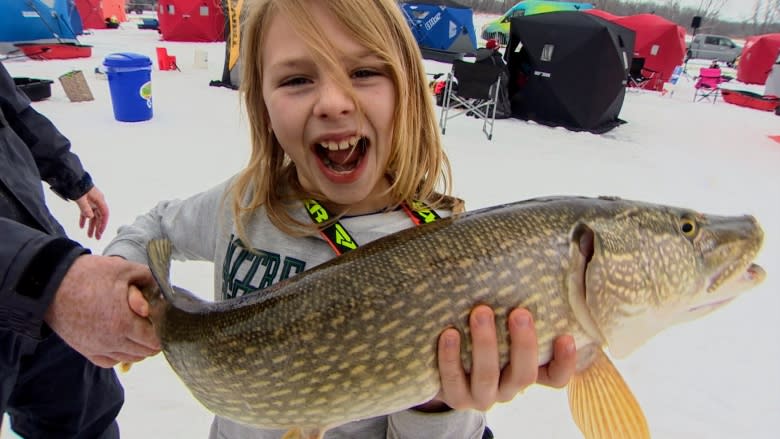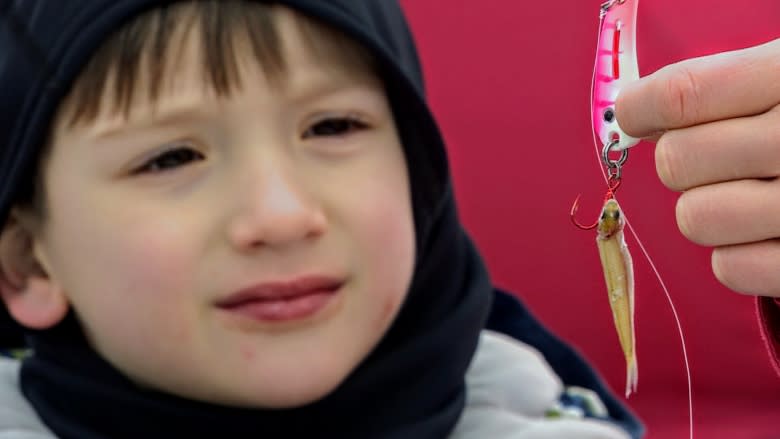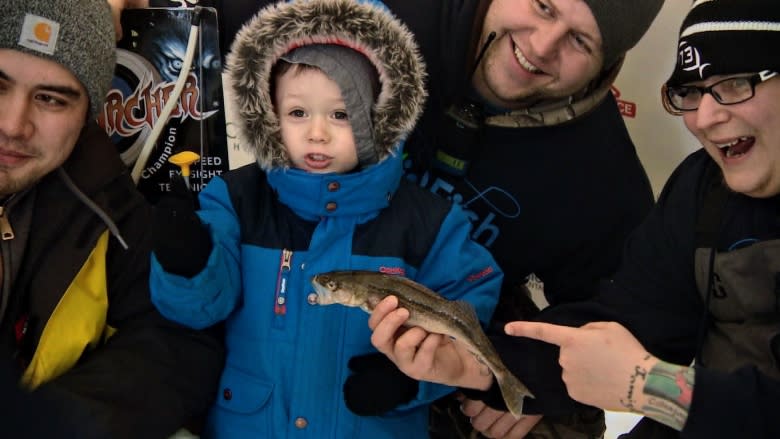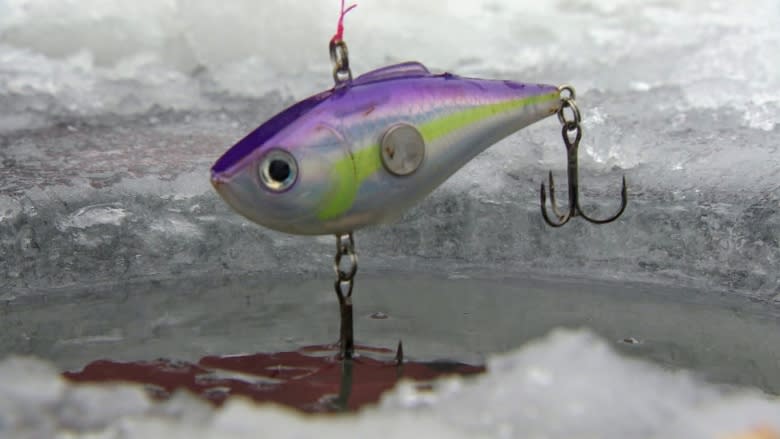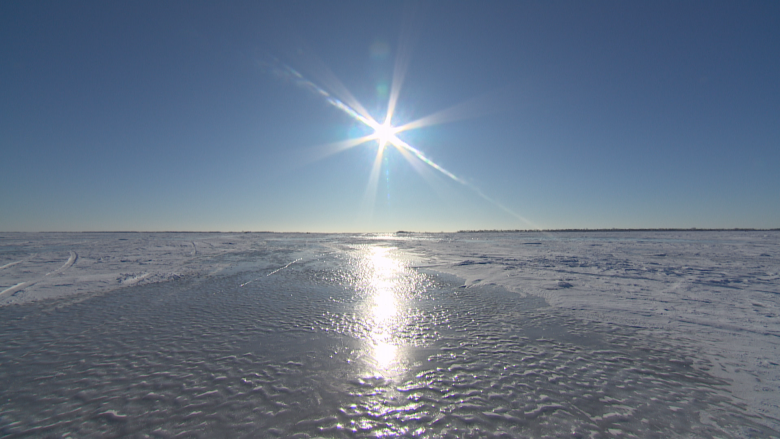'It's a spiritual thing': Ice fishing drawing families, young people, Manitoba enthusiasts say
In a warm tent in the middle of a snowscape on a frozen Manitoba lake, Lee Nolden says there's something about ice fishing that renews the soul.
"I'm not a big churchgoer, because typically in the winter I'm fishing on Sunday morning," he said.
"But for me, just being out in that environment ... I would say it's a spiritual thing for me, watching the sun come up over the lake, being one with nature, experiencing the elements."
The former fishing and hunting guide, nicknamed "the godfather of Lake Winnipeg" in the ice fishing community, got into the sport in 1970s Minnesota, at a time when ice fishing meant trekking on foot through snow onto the ice, chewing a hole through it by hand with a manual auger and spending the next few hours sitting on an upside-down bucket.
Since transplanting to Manitoba 35 years ago, he's watched the sport evolve, so that today's ice fishers are armed with sonar fish finders, power augers, heaters, pop-up tents and more.
"It's more accessible for people. The equipment has changed so drastically now, with some of our fish finders and depth finders that we use, the rods and reels that we use, the line that we use," he said.
"An average family can go out and have a reasonable expectation of catching fish."
He's also seen it grow alongside summer fishing, expanding to include young people, kids and women throughout the province.
"Not that many years ago, it was mostly grumpy old men.… Now it's young people, families. I see kids that are in high school out on their own, doing their own thing, because they like to fish," he said.
"It's a great thing for the sport, I think.… It kind of validates what I like, that other people like it as well. I'm not quite as nuts as people think."
Walleye of 'ginormous proportions'
Since 2013, the number of recreational angling licences — good for summer and winter — has steadily increased from 172,819 in 2013 to 193,294 in 2016, a provincial spokesperson told CBC News in an email.
In 2017, car counters found more than 30,000 vehicles drove onto the popular south basin of Lake Winnipeg in two months alone and more than 1,300 permanent and pop-up shacks were used in that time.
Nolden said a good example of the sport's popularity is the annual KidFish derby at the float plane base — another popular spot for fishers — on the Red River near Selkirk, Man. The fundraiser brought out about 600 people in 2014, its first year.
More than 1,800 fishers came out for the latest derby on Jan. 7 of this year — including 650 kids — and it raised $57,000 for the Children's Hospital Foundation of Manitoba and CancerCare Manitoba Foundation.
"I think the youth already are the ones that do love to fish," organizer Garther Cheung said. The KidFish derby is open to adults, too, but includes kid-friendly features like mascot appearances.
Most anglers Cheung knows got their start fishing with their parents or grandparents, and want to share those experiences with their own kids, he said.
He thinks it's important to get kids involved in sports in general, not just ice fishing.
"Nowadays, I mean, you see lots of kids, they're always inside, playing on their electronics. It's nice to see them see what we have out here in Manitoba," he said.
"It's beautiful, and for them not to see it, lift up their head — it's such a waste."
He said he's seen a boom in fishing on Lake Winnipeg over the past decade, with more and more fishers coming to catch greenback walleye of "ginormous proportions."
"For people that don't know, a greenback walleye, they have this nice green, emerald sheen on them, which is not familiar to the typical gold, black walleye that most people catch," Cheung said.
"That's why you see a lot of the popularity in ice fishing really booming."
'We're lucky'
Carl Realica, 29, didn't start ice fishing until his early 20s, after friends got him into summer fishing when he was younger.
He didn't like it at first, he said, but that changed when he came prepared and dressed for the weather.
"Just knowing that I didn't have to submit to the frigid cold temperatures that we get here in Manitoba. I could still get outside, have fun, get some fresh air," he said.
"And honestly, catching. I know it's not called catching, it's called fishing, but it's obviously more fun if you're catching stuff."
These days, Realica tries to get out once a week.
"One of my goals is actually to catch my lunch for Monday," he said. "But I like socializing with my friends — usually at least three or four of us will go at a time. It's a good way to get outdoors in the winter, socialize with friends, meet new friends."
The sport lets people without expensive boats go fishing in places they'd never be able to reach otherwise, he said, echoing Cheung's endorsement of Manitoba as a top-notch place to fish.
"I think we're lucky to be able to do it," he said. "We can get out to fairly remote places within an hour or two of my door."
He often brings friends out to try it for the first time, he said, although whether or not they enjoy it tends to vary with how successful they are as fishers.
For true newcomers to the sport, he recommended starting with a trip to FortWhyte Alive for a crash course, or seeking out tips on social media, like the Facebook group Ice Fishing Manitoba.
"There's lots of ice fishing information getting traded back and forth," Nolden added. He runs another Facebook group, Lake Winnipeg Ice Fishing.
"Lots of new people are coming on, [asking] 'Hey, where do I go, how do I do it?' and people will come on and give them information on what they can do."
Safety first
Nolden stressed the importance of ice safety for beginners, too. Check the forecast before heading out so you know you won't get stuck in a blizzard, he said, and dress for the weather.
Before you drop a line, choose a spot where other fishers have already set up so you know for sure they're safe, he added. That includes popular spots like the float plane base near Selkirk, where KidFish is held, and the Lake Winnipeg south basin.
Once you've found a safe spot, you can get as comfortable as you choose. Portable tents start at around $300 at places like Cabela's and Canadian Tire, and heaters start at a little over $100.
But Nolden says you don't really need all that if you don't want to shell out for it.
"You can still walk out there with a little pail and an auger and very little investment and catch fish, and be just as successful as a guy like me who's got thousands of dollars of equipment."

